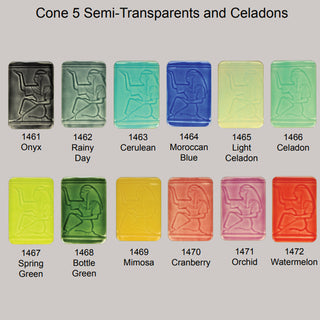SlabMat HAND BUILDING MAT SMALL-14" x 16"
14"x16" Small HandBuilding Mat HandBuilding Mats are made of the same material as our full-sized SlabMats™. They are ideal for smaller hand construction projects. This size mat is used in many class rooms across North America.
SlabMatis the smoooooth alternative to canvas for rolling out slabs of clay. SlabMat is a proprietary non-woven material used instead of canvas on all slab rollers. Smaller mats are avilable for hand building clay slabs.
1. What is SlabMat? SlabMat is a proprietary non-woven fabric that provides a smooth surface for clay work. Unlike canvas, SlabMat has no weave for clay dust to sift through, and therefore is cleaner for studio use.
2. How many pieces of SlabMat do I need? For long slabs (>23") on a slab roller, use two full-length sheets of SlabMat with the clay sandwiched in between. SlabMat can also be used in combination with canvas to get one side textured and one smooth. Place the canvas on the bottom for it to absorb the most water.
For shorter slabs (<23") on a slab roller, use one piece of full size SlabMat folded in half with the clay sandwiched in between the folded mat. Note: If you use this technique for rolling, the crease in the mat is permanent.
For hand building, or slabs rolled out with a rolling pin, you may use one piece of SlabMat. If your table is slick, use a piece of rubber shelf liner under the SlabMat to keep it from sliding.
HandBuildingtm mats are pre-cut to convenient sizes.
3. Can I cut a piece of SlabMat to a smaller size? Yes. Use an Exacto or utility knife and a straight edge to cut the mat to the appropriate size.
4. Can I cut clay sitting on SlabMat? Yes. Cutting clay sitting on SlabMat with an Exacto knife or needle tool requires attention to the sharpness of the tool and the pressure applied when making a cut. Perform a cut test on a SlabMat sample to see how hard you can press before you damage the surface. A stainless steel fettling knife is recommended.
5. Should I buy separate pieces of SlabMat for each type or color of clay? Yes. Avoid clay body contamination.
6. What if my clay sticks to SlabMat? Generally, if you can roll out your clay on canvas, you should be able to use SlabMat without sticking. Cornstarch can be used as a release if lightly dusted onto the mat. It will burn out in the firing.
Tips: When clay is rolled, the bottom mat absorbs more moisture. To prevent you clay from sticking on the bottom mat:
Step 1. Run a thick slab through the slab roller using canvas on the bottom to absorb moisture and SlabMat on the top.
Step 2. Remove the canvas, and replace it with the 2nd sheet of SlabMat. Roll the mat to the desired thickness.
If you still have a problem, you may want to dry the clay somewhat by wedging the clay on plaster or concrete. You can also squeeze the clay into thick coils exposing more surface area to air to dry it.
7. How many slabs can I roll before the SlabMat is too wet? If you remove your slabs immediately, you should be able to roll a few slabs before the SlabMat is too wet. DO NOT LEAVE YOUR CLAY ON THE MAT AFTER ROLLING. TRANSFER TO A FRESH MAT. Prolonged wetness may cause the SlabMat to have a waviness that cannot be corrected.
Tip: If you are slow drying flat slabs, place the slabs between pieces of drywall, also known as gypsum or sheet rock. This product is found at home centers, is easily cut with a utility knife, and is inexpensive. You should cover the drywall edges with duct tape to avoid contamination of clay with the gypsum.
8. How should I store my SlabMats? Store SlabMats flat when possible. If you must store your SlabMats rolled, roll the mats loosely. If the mat is too curled from shipment, gently reverse roll the mat before use. To extend the life of your SlabMat avoid excessive heat and direct sunlight.
CUSTOMER REVIEWS - Q&A
Got a question about this product? Ask it here and get a response from our staff and also input from the Sheffield Pottery community!












